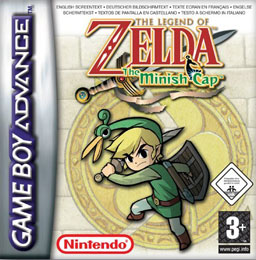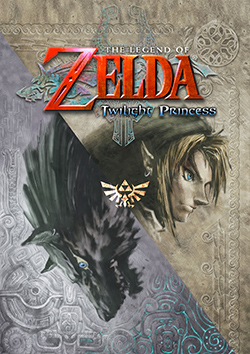
The Legend of Zelda is a media franchise created by the Japanese game designers Shigeru Miyamoto and Takashi Tezuka. It is primarily developed and published by Nintendo; some portable installments and re-releases have been outsourced to Flagship, Vanpool, Grezzo, and Tantalus Media.

The Legend of Zelda: A Link to the Past is an action-adventure game developed and published by Nintendo for the Super Nintendo Entertainment System. It is the third game in The Legend of Zelda series and was released in 1991 in Japan and 1992 in North America and Europe.

The Legend of Zelda: Oracle of Seasons and The Legend of Zelda: Oracle of Ages are 2001 action-adventure games in the Legend of Zelda series. They were developed by Flagship and published by Nintendo for the Game Boy Color.

The Triforce is a fictional artifact and icon of Nintendo's The Legend of Zelda video game franchise. It first appeared in the original The Legend of Zelda video game (1986) and has appeared in every subsequent game in the series. It consists of three equilateral triangles that are joined to form a large equilateral triangle. In-universe, it represents the essences of the Golden Goddesses—Din, Nayru and Farore—who created Hyrule. Imbued with divine power, it is capable of granting any wish to anyone who possesses it.

Princess Zelda is a character in Nintendo's The Legend of Zelda video game series. She was created by Shigeru Miyamoto for the original 1986 game The Legend of Zelda. As one of the central characters in the series, she has appeared in the majority of the games in various incarnations. Zelda is the elf-like Hylian princess of the kingdom of Hyrule, an associate of the series protagonist Link, and bearer of the Triforce of Wisdom.

Link is a fictional character and the protagonist of Nintendo's video game franchise The Legend of Zelda. He was created by Japanese video game designer Shigeru Miyamoto. Link was introduced as the hero of the original The Legend of Zelda video game in 1986 and has appeared in a total of 21 entries in the series, as well as a number of spin-offs. Common elements in the series include Link travelling through Hyrule whilst exploring dungeons, battling creatures, and solving puzzles until he eventually defeats the series' primary antagonist, Ganon, and saves Princess Zelda.

Ganon is a character and the main antagonist of Nintendo's The Legend of Zelda video game series and franchise, as well as the final boss in many Zelda titles. In his humanoid Gerudo form, he is known as Ganondorf. A massive and malevolent porcine creature, Ganon first appeared in the original The Legend of Zelda game in 1986, while his alter ego, Ganondorf, was introduced in Ocarina of Time. He has since appeared in the majority of the games in the series in various forms. He is the archenemy of the protagonist Link and Princess Zelda of Hyrule and originally the leader of the Gerudo, a race of humanoid desert nomads before becoming the ruler of his demon army.

The Legend of Zelda: Four Swords Adventures is an action-adventure game developed and published by Nintendo for the GameCube. It is the eleventh installment in The Legend of Zelda series. It was released in 2004 in Japan on March 18, and in North America on June 7. In 2005, the game was released in Europe on January 7, and in Australia on April 7. The Game Boy Advance handheld game console can be used as a controller when using the GameCube – Game Boy Advance link cable bundled with the game in North America and Europe.
Masashi Kishimoto is a Japanese manga artist. His manga series, Naruto, which was in serialization from 1999 to 2014, has sold over 250 million copies worldwide in 46 countries as of May 2019. The series has been adapted into two anime and multiple films, video games, and related media. Besides the Naruto manga, Kishimoto also personally supervised the two canonical anime films, The Last: Naruto the Movie and Boruto: Naruto the Movie, and has written several one-shot stories. In 2019, Kishimoto wrote Samurai 8: The Tale of Hachimaru which ended in March 2020. From May 2016 through October 2020 he supervised the Boruto: Naruto Next Generations manga written by Ukyō Kodachi and illustrated by Mikio Ikemoto. In November 2020 it was announced that he had taken over as writer on the series, replacing Kodachi.

The Legend of Zelda: The Minish Cap is an action-adventure game and the twelfth entry in The Legend of Zelda series. Developed by Capcom and Flagship, with Nintendo overseeing the development process, The Minish Cap was released for the Game Boy Advance in Japan and Europe in 2004 and in North America and Australia the following year.

The Legend of Zelda: Twilight Princess is a 2006 action-adventure game developed and published by Nintendo for the GameCube and Wii. Originally planned for release exclusively on the GameCube in November 2005, Twilight Princess was delayed by Nintendo to allow its developers to refine the game, add more content, and port it to the Wii. The Wii version was a launch game in North America in November 2006, and in Japan, Europe, and Australia the following month. The GameCube version was released in December 2006 as the final first-party game for the console.

Tingle is a recurring character in The Legend of Zelda series, designed by Takaya Imamura. He first appeared in Majora's Mask, where he is a map salesman who wants to become a fairy. He has since appeared in several installments, including The Wind Waker, where he provides maps to help Link find pieces of the Triforce. He has gone on to be the star of Freshly-Picked Tingle's Rosy Rupeeland, where his origin as Tingle is shown as him tasked with collecting as many Rupees as possible. He also appears in its sequel Irozuki Tingle no Koi no Balloon Trip, where he is transported into a storybook and has to enter into relationships with women in order to escape.

Midna is a fictional character in Nintendo's The Legend of Zelda series, introduced as one of the main protagonists in Twilight Princess. She is a member of the magic-wielding Twili who joins forces with Link to prevent the kingdom of Hyrule from being enveloped by a corrupted parallel dimension known as the Twilight Realm. While Midna appears as an imp-like creature in the majority of Twilight Princess, her actual form is humanoid. She was designed by Yusuke Nakano and voiced by Akiko Kōmoto. Midna also appears as a playable character in Hyrule Warriors, and makes minor appearances in the Super Smash Bros. series.

The Legend of Zelda: Hyrule Historia is a collector's book about Nintendo's The Legend of Zelda series, published in English by Dark Horse Comics. The 276-page book reveals the official timeline of the fictional events in the series, following years of speculation by fans. The book also includes artwork for the games, a short manga, and a foreword and afterword written by the series' producers. It is the first in an official trilogy of art books known as the "Goddess Collection" that was published by Dark Horse in partnership with Nintendo and was completed by the publication of The Legend of Zelda: Art & Artifacts and The Legend of Zelda Encyclopedia. Hyrule Historia topped Amazon.com's list of bestselling books in February 2013 and was Amazon's sixth best-selling print book of 2013.

Takeshi Yamamoto is a fictional character in the Reborn! manga and anime series created by Akira Amano. Portrayed as one of the protagonist's first friends, Takeshi Yamamoto is introduced as a 14-year-old starting pitcher for his school's baseball team. Apart from the manga and anime, Yamamoto has also appeared in other media from the Reborn! franchise including video games.
Akira Himekawa is the pen name of a duo of female Japanese comic book artists. When writing original works, the pen name is spelled as Akira Himekawa

The Legend of Zelda: Twilight Princess is a Japanese manga series written and illustrated by Akira Himekawa, and is based on the video game of the same name. It was serialized through Shogakukan's MangaONE app from February 2016 to January 2022, and spans 58 chapters across 11 volumes.

The Legend of Zelda Encyclopedia is a book about Nintendo's The Legend of Zelda video game series. It is published in English by Dark Horse Comics and is the third book in the "Goddess Collection" trilogy, following the publication of Hyrule Historia and Art & Artifacts. The encyclopedia was released to celebrate the 30th anniversary of The Legend of Zelda series. It provides a detailed compendium of the numerous fictional characters, creatures and items found within the first 30 years of the Zelda game series. It was published as a standard edition with a blue cover and a deluxe edition with a gold NES cartridge design in June 2018.














